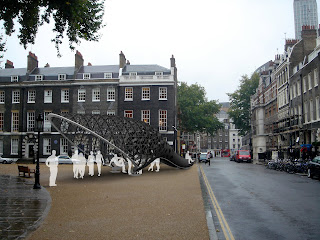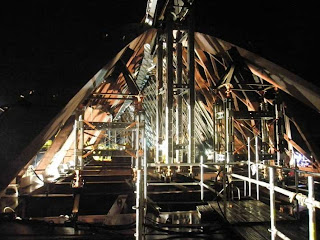Tuesday, October 30, 2007
panoramic set
Zaragoza Bridge Pavilion
DRL TEN Pavilion
The panels have been designed based on the structural principle of corrugation, folding a flat sheet of material to increase its structural properties. The edges of the panels are folded to create rigid modules. The modules are stacked and bolted together with steel plate connections to form ribs, and each rib is fastened together to create an overall rigid tubular system. The folded edges of the modules transfer vertical forces to the laminated timber support structure. The infill surface of the module serves for lateral bracing and can be milled with a pattern to reduce material weight in areas of larger spans, creating a play between solid and transparency.
The challenge was to create repetition in the modules while trying to follow the complex curvature of the pavilion’s form. By breaking apart the overall form into typical zones, five moulds can be used to fold the wet fibre-c sheets. Each mould can create between four and six variations resulting in a total of 22 unique panel types.
Looking at a rule based system of neighbour associations, a voronoi script was used to produce the tessellation pattern, maintaining the surface’s structural requirement through its triangulated apertures. Using variation in flat panel sizes and applying apertures in specific locations created a pixelization of the pavilion’s surface and was enhanced by using five shades of grey standard to the fibre-c collection.





Monday, October 29, 2007
DRL TEN Pavilion
The pavilion is a formal expression of the growth of the DRL, starting from a small tail growing and engulfing everyone that comes to see it, reflecting the foundation of the graduate programme to the DRL’s current worldwide recognition and prestige.
The edges of the fibre-c panels are folded to create a rigid framed module. The modules are stacked and fastened together to form a structural rib, each rib is fastened together to create a rigid structural tubular system. In one direction the edges of the fibre-c modules behave as rings to transfer the weight down to the laminated timber support structure. In the other direction the edges act as lateral bracing. The infill pieces of the modules can then be milled with a pattern to create a global emergent effect as well as reducing material weight in areas of larger spans.
The challenge is to create repetition in the modules, by breaking apart the overall form into zones, each zone will use a unique module type. The module types range from square (at both ends of the pavilion) to diamond shaped (at the center of the pavilion), and infill pattern curvature goes from single (both ends of pavilion) to conical (at the center of the pavilion).




























